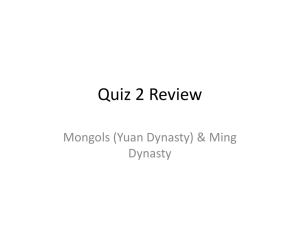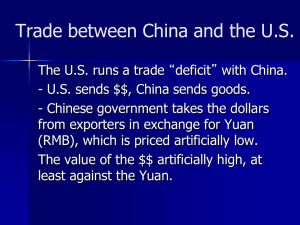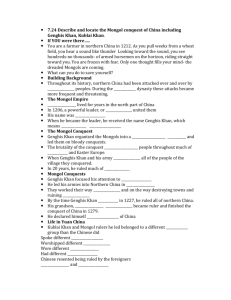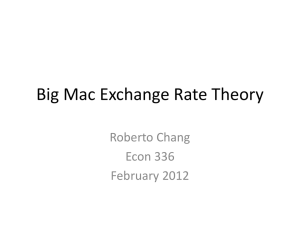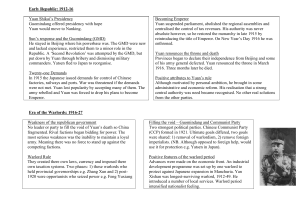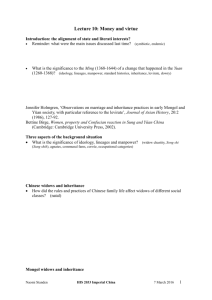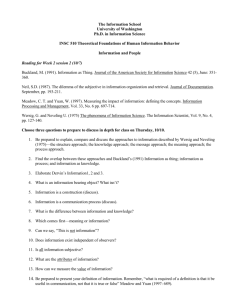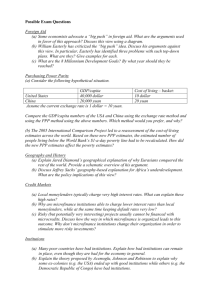syllabusspring06
advertisement
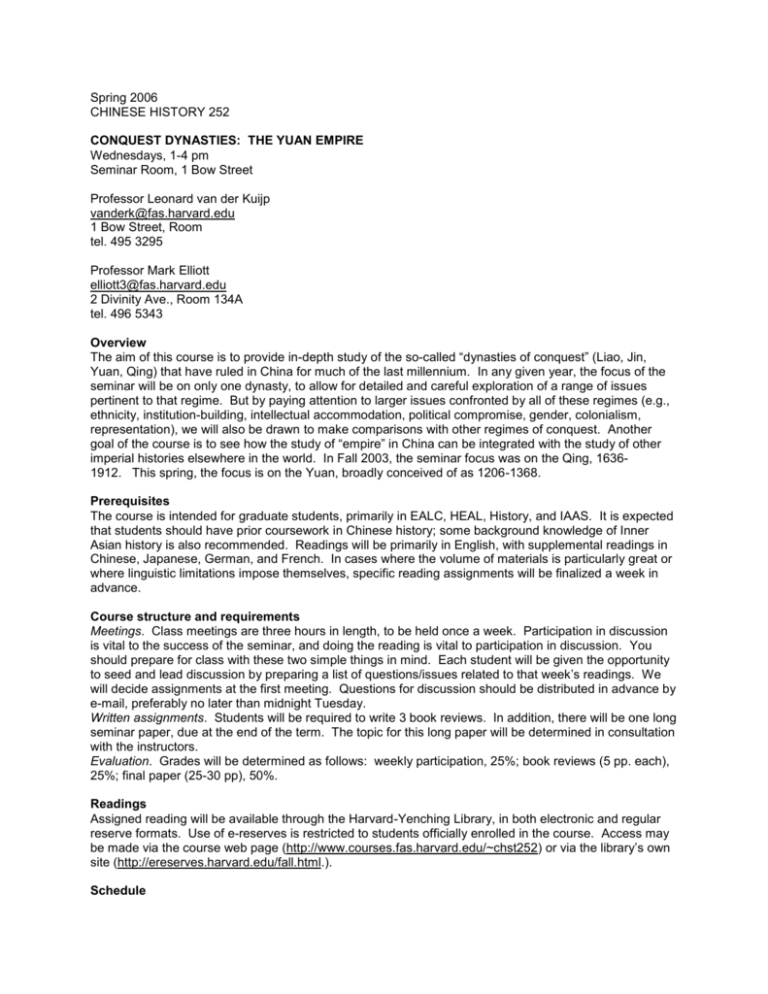
Spring 2006 CHINESE HISTORY 252 CONQUEST DYNASTIES: THE YUAN EMPIRE Wednesdays, 1-4 pm Seminar Room, 1 Bow Street Professor Leonard van der Kuijp vanderk@fas.harvard.edu 1 Bow Street, Room tel. 495 3295 Professor Mark Elliott elliott3@fas.harvard.edu 2 Divinity Ave., Room 134A tel. 496 5343 Overview The aim of this course is to provide in-depth study of the so-called “dynasties of conquest” (Liao, Jin, Yuan, Qing) that have ruled in China for much of the last millennium. In any given year, the focus of the seminar will be on only one dynasty, to allow for detailed and careful exploration of a range of issues pertinent to that regime. But by paying attention to larger issues confronted by all of these regimes (e.g., ethnicity, institution-building, intellectual accommodation, political compromise, gender, colonialism, representation), we will also be drawn to make comparisons with other regimes of conquest. Another goal of the course is to see how the study of “empire” in China can be integrated with the study of other imperial histories elsewhere in the world. In Fall 2003, the seminar focus was on the Qing, 16361912. This spring, the focus is on the Yuan, broadly conceived of as 1206-1368. Prerequisites The course is intended for graduate students, primarily in EALC, HEAL, History, and IAAS. It is expected that students should have prior coursework in Chinese history; some background knowledge of Inner Asian history is also recommended. Readings will be primarily in English, with supplemental readings in Chinese, Japanese, German, and French. In cases where the volume of materials is particularly great or where linguistic limitations impose themselves, specific reading assignments will be finalized a week in advance. Course structure and requirements Meetings. Class meetings are three hours in length, to be held once a week. Participation in discussion is vital to the success of the seminar, and doing the reading is vital to participation in discussion. You should prepare for class with these two simple things in mind. Each student will be given the opportunity to seed and lead discussion by preparing a list of questions/issues related to that week’s readings. We will decide assignments at the first meeting. Questions for discussion should be distributed in advance by e-mail, preferably no later than midnight Tuesday. Written assignments. Students will be required to write 3 book reviews. In addition, there will be one long seminar paper, due at the end of the term. The topic for this long paper will be determined in consultation with the instructors. Evaluation. Grades will be determined as follows: weekly participation, 25%; book reviews (5 pp. each), 25%; final paper (25-30 pp), 50%. Readings Assigned reading will be available through the Harvard-Yenching Library, in both electronic and regular reserve formats. Use of e-reserves is restricted to students officially enrolled in the course. Access may be made via the course web page (http://www.courses.fas.harvard.edu/~chst252) or via the library’s own site (http://ereserves.harvard.edu/fall.html.). Schedule Week 1 – 1 February Introduction Week 2 – 8 February Nomadic rule in China Wolfram Eberhard, “Patterns of Nomadic Rule,” in Conquerors and Rulers: Social Forces in Medieval China (Leiden: EJ Brill, 1970), 107-139. Thomas Barfield, The Perilous Frontier (Blackwell, 1989) Joseph Fletcher, “The Mongols: Ecological and Social Perspectives,” Harvard Journal of Asiatic Studies 46.1 (June 1986), 11-50. Peter Golden, Nomads and Sedentary Societies in Medieval Eurasia (Washington, DC: AHA, 1998). Week 3 – 15 February The idea of the conquest dynasty Denis F. Twitchett and Herbert Franke, “Introduction,” in Twitchett and Franke, eds., The Cambridge History of China, vol. 6 (Cambridge, 1996), 1-42. Karl Wittfogel and Feng Chia-sheng, to History of Chinese Society: Liao (Philadelphia: American Philosophical Society, 1949), 1-35 (“Introduction”). Herbert Franke, “The Role of the State as a Structural Element in Polyethnic Societies,” in Stuart Schram, ed., Foundations and Limits of State Power in China (Hong Kong: CUHK, 1987), 87-112. Fujieda Akira, “Ryō-Kin-Genshi no kadai,” in Seifuku ōchō (Osaka: Akitaya,1948), pp. 13-29. Kuwabara Jitsuzō, “Chūgoku seifuku ōchō ni tsuite,” in Chūgoku seifuku ōchō no kenkyū (Kyoto: Kyoto University Press, 1971), vol. 2, pp. 623-641. Mori Masao, “Futatabi seifuku ōchō ni tsuite,” Shiruku rōdo 6.2 (February 1980). Sun Jinyi, “Guanyu ‘zhengfu wangchao lun’,” Liao-Jin Qidan-Nüzhenshi yanjiu dongtai 1-14 (1982/83), pp. 22-23. Week 4 – 22 February Concepts and terms in Yuan history Ernst Kantorowicz, The King’s Two Bodies: A Study in Medieval Political Theology (Princeton: Princeton University Press, 1957; reprinted 1997). Johan Elverskog, “Superscribing the Hegemonic Image of Chinggis Khan in the Erdeni Tunumal Sudur,” in B.N. Schyler and M. Juntunen, eds., Re-Entering the Silk Routes: Current Scandinavian Research on Central Asia (London: Kegan Paul International, 2000), pp. 63-74. Klaus Sagaster, Die Weisse Geschichte (Wiesbaden: Harrassowitz, 1976). James Hevia, “Lamas, Emperors and Rituals: Political Implications in Qing Imperial Ceremonies,” Journal of the International Association of Buddhist Studies 16.2 (1993), pp. 243-278. Paul Buell, “Tribe, Qan, and Ulus in Early Mongol China,” PhD dissertation, University of Washington, 1977. Igor De Rachewiltz, “Qan, Qa’an and the Seal of Güyüg,” in Klaus Sagaster and Michael Weiers, eds., Documenta Barbarorum: Festschrift für Walther Heissig zum 70. Geburtstag” (Wiesbaden: Harrassowitz, 1983, pp. 272-281. Hsiao Ch’i-ch’ing, “Shuo ‘Da Yuan’: Yuanchao jianhao qian Menggu de Hanwen guohao,” in Meng-Yuan shi xin yan (Taipei: 1994). Week 5 – 1 March The Chinggisid expansion: foundations of empire Igor de Rachewiltz, trans., The Secret History of the Mongols (Leiden: EJ Brill, 2004), vol. 1. Paul Ratchnevsky, Genghis Khan, Life and Legacy (Oxford: Blackwell, 1992). David Morgan, The Mongols (Oxford: Blackwell, 1990). Michael Doyle, Empires (Cornell, 1986) (excerpts) Sugiyama Masaaki, “Rekishi o kataru monotachi,” preface to Mongoru teikoku no kōbō (Tokyo: Kodansha, 1996), pp. 8-25. Week 6 – 8 March The Yuan emperors Herbert Franke, “From Tribal Chieftain to Universal Emperor and God: The Legitimation of the Yuan Dynasty,” in Herbert Franke, China under Mongol Rule (Variorum, 1994), 7-84. Hok-lam Chan, Legitimation in Imperial China: Discussions under the Jurchen-Chin Dynasty (1115-1234) (Seattle: Univ. of Washington Press, 1984). Thomas Allsen, Mongol Imperialism: The Policies of the Grand Khan Mongke (Berkeley: Univ of California, 1987). Morris Rossabi, “The Reign of Khubilai Khan,” in Franke and Twitchett, eds., Cambridge History of China vol. 6 (Cambridge: Cambridge University Press, 1994), pp. 414-489. Song Lian, et al., eds., Yuan shi (Beijing: Zhonghua shuju, 1976), 210 juan. (excerpts) Week 7 – 15 March Military organization Hsiao Ch’i-ch’ing, The Military Establishment of the Yuan Dynasty (Cambridge: Council on East Asian Studies, 1978). John Masson Smith, “Nomads on Ponies vs. Slaves on Horses,” JAOS 118 (1998), pp. 54-62. John Herman, “The Mongol Conquest of Dali,” in Nicola Di Cosmo, ed., Warfare in Inner Asian History (Brill, 2002), pp. 295-334. Thomas Allsen, “The Circulation of Military Technology in the Mongol Empire,” in Nicola di Cosmo ed., Warfare in Inner Asian History (Brill, 2002), pp. 265-293. Yonggyu Lee, “Seeking Loyalty: The Inner Asian Tradition of Personal Guards and its Influence in Persia and China,” PhD dissertation, Harvard University, 2004. Week 8 – 22 March Women and marriage Bettine Birge, “Levirate Marriage and the Revival of Widow Chastity in Yuan China,” Asia Major 8 (1995), pp. 107-146. Francis W. Cleaves, “The Biography of the Empress Chabi in the Yuan shi,” Harvard Ukrainian Studies 34 (1979-80), pp. 138-150. Herbert Franke, “Women under the Dynasties of Conquest,” in Lionello Lanciotti, ed., La Donna nella Cina imperiale e nella Cina repubblicana (Florence, 1980), pp. 23-43. Jennifer Holmgren, “Observations on Marriage and Inheritance Practices in Early Mongol & Yuan Society, with Particular Reference to the Levirate,” Journal of Asian History 20 (1986), pp. 127-192. Morris Rossabi, “Khubilai Khan and the Women in his Family,” in Wolfgang Bauer, ed., Studia SinoMongolica : Festschrift fur Herbert Franke (Wiesbaden: Steiner, 1979), pp. 153-180. Paul Smith, "Fear of Gynarchy in an Age of Chaos: Kong Qi's reflections on life in South China under Mongol Rule," JESHO 41.1 (1998) 1-95. 29 March -- SPRING BREAK Week 9 – 5 April Mongolia, Tibet, and religious life Paul Ratchnevsky, “Über den mongolischen Kult am Hofe der Grosskhane in China,” in L. Ligeti, ed., Mongolian Studies (Budapest: Akademiai Kiado, 1970), pp. 417-43. Yuanchao shi, ed.Han Rulin, vol. 2 (Beijing: Renmin chubanshe, 1986), pp. 245-73, 338-60. Herbert Franke, “Tibetans in Yuan China,” in John Langlois, ed., China under Mongol Rule (Princeton: Princeton University Press, 1981), pp. 296-328. Luciano Petech, “’Phags-pa,” in Igor de Rachewiltz, et al., eds., In the Service of the Khan: Eminent Pesonalities of the Early Mongol-Yuan Period (Wiesbaden: Harrassowitz, 1993), pp. 646-654. Shen Weirong, “Magic Power, Sorcery and Evil Spirit: The Image of Tibetan Monks in Chinese Literature during the Yuan Dynasty,” in C. Cüppers, ed. (Lumbini: Lumbini International Research Center, 2004), pp. 189-227. Ruth Dunnell, “The Hsia Origins of the Yuan Institution of the Imperial Preceptor,” Asia Major 5 (1992), pp. 85-111. Turrell Wylie, “The First Mongol Conquest of Tibet,” HJAS 37 (1977), pp. 103-133. Week 10 – 12 April Law, government, and society Paul Chen, Chinese Legal Tradition under the Mongols (Princeton: Princeton University Press, 1979). Elizabeth Endicott-West, “Imperial Governance in Yuan Times,” HJAS 46.2 (December 1986), pp. 523549. Paul Ratchnevsky, Un code des Yuan (Paris, 1985). David Farquhar, The Government of China under Mongol Rule: A Reference Guide (Stuttgart: Steiner, 1990). Frederick Mote, “Chinese Society under Mongol Rule, 1215-1368,” in Franke and Twitchett, eds., Cambridge History of China vol. 6 (Cambridge: Cambridge University Press, 1994), pp. 616-664. Week 11 – 19 April Epigraphical monuments Murata Jirō, Kyūyōkan (Kyoto: 1955-1957). Nicholas Poppe and John Krueger, The Mongolian Monuments in ‘Phags-pa Script (Wiesbaden: Harrassowitz, 1957). Francis W. Cleaves, “Selected Sino-Tibetan Inscriptons” in HJAS (5 or 6 articles) Dieter Schuh, Erlasse und Sendschreiben Mongolischer Herrscher für tibetische Geistliche (St. Augustin: VGH Wissenschaftsverlag, 1977). Week 12 – 26 April Ethnicity and acculturation Herbert Franke, “Could the Yuan Emperors Read Chinese?” Asia Major III (1952), pp. 28-41. Hsiao Ch’i-ch’ing, “Lun Yuandai Menggu ren zhi Hanhua,” in Meng-Yuan shi xin yan (Taipei: 1994). Igor de Rachewiltz, “Yeh-lü Ch’u-ts’ai (1189-1243): Buddhist Idealist and Confucian Statesman,” in Arthur Wright and Denis Twitchett, eds., Confucian Personalities (Stanford: Stanford University Press, 1962), pp. 189-216. John Langlois, “Chinese Culturalism and the Yuan Analogy: 17th-century Perspectives,” HJAS 40 (1980): pp. 355-398. Chen Yuan, Western and Central Asians in China under the Mongols: Their Transformation into Chinese, trans. L. Carrington Goodrich (Netetal: 1989). Biographies of Ahmed and Sanggha in In the Service of the Khan Ichisada Miyazaki, “Genchō chika no Mōkōteki kanshoku o meguru Mō-Kan kankei,” Tōyōshi kenkyū 23.4 (March 1965), pp. 68-91. John Dardess, “The Triumph of Confucian Politics,” in John Dardess, Conquerors and Confucians (New York: Columbia U. Press, 1973), pp. 75-94. Week 13 – 3 May Medicine and material culture Paul Buell and Eugene Anderson, A Soup for the Qan: Dietary Medicine of the Mongol Era (London: Kegan Paul, 2000). Thomas Allsen, Commodity and Exchange in the Mongol Empire (Cambridge: Cambridge University Press, 1997). Marco Polo, The Travels (excerpts). Jutta Rall, Die vier grossen Medizinschulen der Mongolenzeit (Wiesbaden: F. Steiner, 1970). Han Rulin, “Yiyaoxue,” in Han, Yuanchao shi, vol. 2 (Beijing: Renmin chubanshe, 1986), pp. 380-383. Reiko Shinno, “Promoting medicine in the Yuan dynasty (1206-1368): An aspect of Mongol rule in China,” Ph.D. dissertation, Stanford University, 2002.

